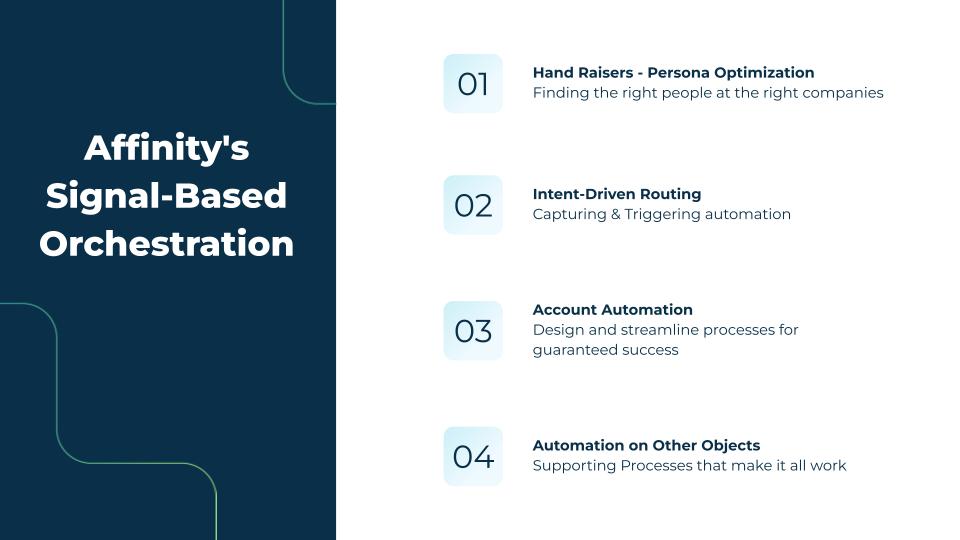Your best leads rarely raise their hands and shout, I’m ready to buy!
Most of the time, they drop hints.
These hints, or signals, can help revenue teams work smarter. However, only if you know how to collect, test, and use them.
Raheel Alam, Applications Manager at Affinity and 2021 OpsStar of the Year, shared his approach in a recent LeanData webinar. Today, Raheel builds a signal-based architecture at Affinity that empowers both sellers and operations teams.
Here’s a step-by-step guide to Raheel’s signal-based GTM strategy.

Step 1: Understand What Counts as a Signal
At Affinity, Raheel and his team gather many kinds of buying signals. For example, they track when a private capital firm starts raising a new fund. That activity often means the firm will need new software.
They also monitor when past users of Affinity change jobs and join new firms. That signals a possible customer conversation. Even simple web activity, such as visiting the pricing page, can be a signal.
“The whole point of these signals is to give context,” Raheel explains. “They are not infinite things that last forever.“
The key is to choose signals that reveal buyer interest or business changes.
Step 2: Start Small and Test
It is tempting to track everything. However, Raheel warns against this.
At Affinity, his team started with just five to six signals. They picked signals that most often led to real sales conversations. For example, signals included a firm raising funds and a known user moving companies.
Rather than assume these signals mattered, they tested them. First, they watched which signals led to meetings and which did not. In fact, they collected data over a full quarter before making changes.
Therefore, they focused only on signals that delivered results. This also avoided overwhelming their sellers.
Step 3: Build Context, Not Noise
Signals should not just alert sellers. They should tell a story.
For example, when an Affinity prospect raises funds and a former user joins that company, both signals combine.
The team alerts the account executive and shares the full story. Instead of saying, “This company is raising funds,” the message explains why that matters.
Raheel shares, “You are not writing a person, you are writing a story.”
That context helps sellers craft relevant outreach.
Raheel’s team avoids sending a long list of signals. Instead, they summarize the most important ones.

Step 4: Keep Signals Fresh
Signals have an expiration date.
Raheel compares them to fresh produce. The longer you wait, the less valuable they become. For instance, if a company started raising funds three months ago, that might be old news.
At Affinity, signals expire after 30 to 60 days. If sellers do not act in that window, the signals go stale. “This is not like wine. This is going to not age very well,” Raheel jokes.
Therefore, the team stays focused on fresh opportunities.
Step 5: Expand Beyond Prospects
Signals are not just for finding new customers. They can also reveal opportunities or risks in current accounts.
For example, if an existing customer starts raising a new fund, that signals a possible expansion. The customer success manager receives that signal.
Next, they can engage the customer about new needs or growth plans. This proactive approach improves customer relationships. It also helps avoid surprises.
If a customer starts showing signals of downsizing, the team can respond early.
Step 6: Use Signals to Trigger Smart Actions
At Affinity, signals do not just inform people. They drive actions.
For example, when a signal appears, LeanData orchestration updates fields in Salesforce.
These updates might assign the account to the right rep or notify the customer success team. In some cases, the system automatically adds the account to the right sales sequence.
Raheel’s team even enriches data when needed.
“If the right contact is not already in Salesforce, an automation finds and adds them,” he says. This saves time and makes sure the right people are engaged.

Step 7: Review and Refine Regularly
No signal strategy stays perfect forever.
Raheel recommends reviewing signal performance often. Which signals lead to meetings? What signals consistently lead to closed deals? Are some signals false alarms?
Based on this data, Affinity refines their signals. Also, they stay open to adding new signals or retiring old ones.
Consequently, the system stays effective even as market conditions change.

Start Small. Test. Refine. Succeed.
Signals can make or break your go-to-market strategy.
Raheel Alam’s approach at Affinity shows that success does not come from tracking every possible data point. Instead, it comes from choosing the right signals, testing them carefully, and providing context to your teams.
“Start somewhere,” Raheel advises. “Do not try to eat the whole elephant at once.”
Most importantly, Raheel reminds us that building a signal-based GTM strategy takes time.
Start small. Test. Refine.
Over time, you will give your sellers not just leads but real stories they can act on. These will lead to better conversations, stronger relationships, and more revenue.











